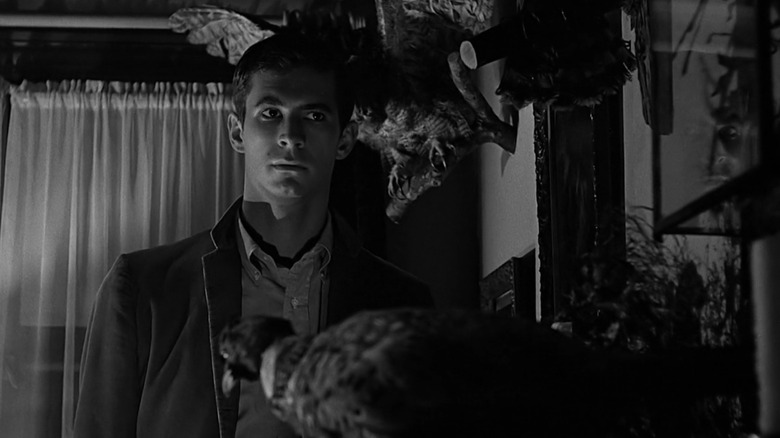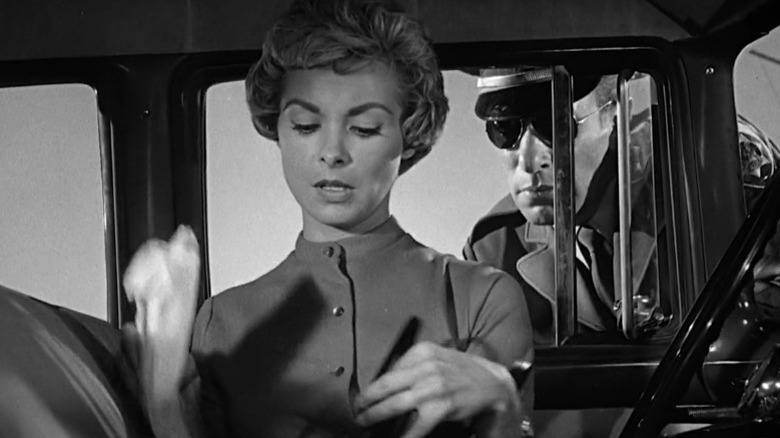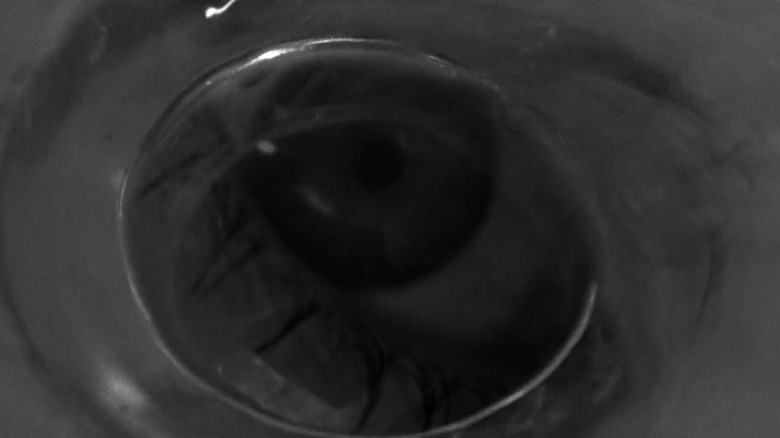The Psycho Controversy Explained
Nothing riles up the public quite like a horror film. For pretty much the entire last century and still somehow continuing into this one, movies of the macabre have attracted the biggest scolding of any film genre in Hollywood. People fear the unknown, and horror, suspense, and thriller films live in those realms. They revel in the naughty and uncouth, so it's no wonder that horror cinema also seems to depict the most daring cinematic depictions of sexuality as much they do death, religion, and the supernatural.
Alfred Hitchcock's "Psycho" is, of course, a landmark of the genre, but even watching it today, the frank depictions of sexual relationships as well as the unknowable terror of psychosis fill the screen in ways that feel inventive. Hitchcock's masterful film utilizes sound that puts viewers on edge and camerawork that pokes and prods at their worst anxieties.
The film was released in 1960 at the cusp of a decade of great change in Hollywood and perhaps, because of its filmmaker's daring to tear down the puritanical shields of what was considered "appropriate," may have been a signature catalyst for the visionary filmmaking to come in the coming decades from Hollywood's greatest modern auteurs.
Making the Most of Horror
"Psycho" wastes no time in establishing its provocative intents. It begins with Marion Crane (Janet Leigh), a secretary at a real estate company, having an afternoon tryst with a man in a hotel room. Though it was much weaker than in the previous decades, the Motion Picture Production Code (popularly known as the Hays Code) was still operating during the time "Psycho" released and audiences were not used to such openness regarding affairs and sexual exploits. Depictions of violence and sexuality during the time were usually subtle and symbolic, but "Psycho" dove in head-first and pushed boundaries.
The owner of the hotel, Norman Bates (Anthony Perkins), was a uniquely disturbing villain for his time. A curious and disturbed young man, Bates wore his dead mother's clothing from time to time, something that lead to inferences of queerness in the character and were discomforting to a still culturally sheltered American mainstream (the film using that queerness as shorthand for a madman has become its own controversy over the years).
The nudity and violence in the film culminated in the shocking shower sequence after Marion reaches the Bates Motel. Many simplistic products and techniques were used to create the deeply effective sound and visuals that are core to the movie's most famous scene. Knives plunging into casaba fruits were used to simulate stabbing, Hershey's chocolate syrup resembled the dark and viscous look of blood, Bernard Hermann's score is ingeniously simple — just one screeching chord played over and over in succession and great force. Most importantly, the sequences was cut in rapid short close-up shots to imply all of its violence without actually showing any of it.
Turning Obstacles Into Imaginative Opportunities
Hitchcock ran into issues with the studio regarding the violence and sexuality in the screenplay, which was adapted from the novel by Robert Bloch. Paramount Pictures gave the filmmaker a tough time, reducing his budget to $3 million and keeping equipment scarce. Eventually Hitchcock was left with $1 million and chose to shoot in black-and-white. However, these tactics were hardly an obstacle for an imaginative and inventive auteur like Hitchcock. He used the barebones formal techniques of cinema to build the film's tension slowly and steadily into a full-on nightmare. The corner that Hitchcock was forced into, thinking the film's provocations would be stemmed, actually served as the catalyst for the film's notoriety and ultimate fame among audiences. Film critic J. Hoberman described the audience reaction to the movie at its premiere in 1960:
Audiences responded as though trapped on a roller coaster through the spook house, with a convulsive mixture of screams and laughter. People bolted for the doors and fainted in their seats. The mayhem caused one New York theater to call the cops and others to call for censorship. For a few weeks, Psycho upstaged the presidential campaign.
While it played to shocked audiences in the United States, the movie was banned in several countries, including Ireland, and UK censors forced several cuts to the stabbing sequences. Controversy over the film continues even today, especially in an era of greater awareness of mental health, towards Norman Bates' Dissociative Identity Disorder.
The film's reputation as a controversial, violent, and sexual experience paved the way not only for the coming decade of violently charged horror cinema — including George A. Romero's "Night of the Living Dead" less than a decade later and the slasher era of the late-70s and 80s — but also New Hollywood, which set the mandate for deeply felt, artistic work from auteurs working on tight budgets. It remains to this day a landmark film and one that is time and time again referenced and re-released in new forms for new generations.


